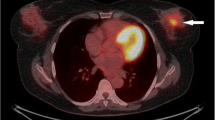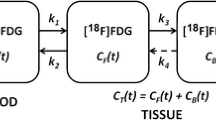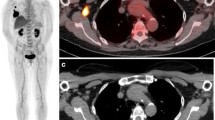Abstract
Purpose
We used small animal positron emission tomography (PET) imaging to monitor the time-course of tumor metabolic response to hormone and chemotherapy in a murine model of hormone-sensitive breast cancer.
Procedures
Estrogen receptor positive murine mammary carcinomas were inoculated in Balb/c mice. Small animal PET imaging using 2-deoxy-2-[F-18]fluoro-d-glucose (FDG) was used to assess tumor metabolic activity. Imaging was done before and at days 1, 7, and 14 after the administration of doxorubicin, methotrexate, letrozole, or placebo. The tumor uptake of FDG was calculated from a region-of-interest drawn around the tumor.
Results
All treatments resulted in a decrease in tumor growth rate and end volume compared to untreated control. FDG uptake was also markedly decreased after treatment although a flare reaction was observed on PET at day 7, the intensity of which varied according to the treatment modality.
Conclusion
PET imaging is sensitive to detect early changes associated with therapy in murine breast cancer models. A flare reaction was observed 7 days after the initiation of therapy.






Similar content being viewed by others
References
Volk EL, Rohde K, Rhee M, et al. (2000) Methotrexate cross-resistance in a mitoxantrone-selected multidrug-resistant MCF7 breast cancer cell line is attributable to enhanced energy-dependent drug efflux. Cancer Res 60:3514–3521
Dowsett M (2001) Overexpression of HER-2 as a resistance mechanism to hormonal therapy for breast cancer. Endocr-Relat Cancer 8:191–519
Clarke R, Leonessa F, Welch JN, Skaar C (2001) Cellular and molecular pharmacology of antiestrogen action and resistance. Pharmacol Rev 53:25–71
Benard F, Turcotte E (2005) Imaging in breast cancer: single-photon computed tomography and positron-emission tomography. Breast Cancer Res 7:153–162
Aliaga A, Rousseau JA, Ouellette R, et al. (2004) Breast cancer models to study the expression of estrogen receptors with small animal PET imaging. Nucl Med Biol 31:761–770
Hamacher K, Coenen HH, Stocklin G (1986) Efficient stereospecific synthesis of no-carrier-added 2-[18F]-fluoro-2-deoxy-D-glucose using aminopolyether supported nucleophilic substitution. J Nucl Med 27:235–238
Lanari C, Luthy I., Lamb CA, et al. (2001) Five novel hormone-responsive cell lines derived from murine mammary ductal carcinomas: in vivo and in vitro effects of estrogens and progestins. Cancer Res 61:293–302
Tomayko MM, Reynolds CP (1989) Determination of subcutaneous tumor size in athymic (nude) mice. Cancer Chemother Pharmacol 24:148–154
Lecomte R, Cadorette J, Richard P, Rodrigue S, Rouleau D (1994) Design and engineering aspects of a high resolution positron tomograph for small animal imaging. IEEE Trans Nucl Sci 41:1446–1452
Lecomte R, Cadorette J, Rodrigue S, et al. (1996) Initial results from the Sherbrooke avalanche photodiode positron tomograph. IEEE Trans Nucl Sci 43:1952–1957
Selivanov V, Picard Y, Cadorette J, Rodrigue S, Lecomte R (2000) Detector response models for statistical iterative image reconstruction in high resolution PET. IEEE Trans Nucl Sci 47:1168–1175
Keyes JW Jr (1995) SUV: standard uptake or silly useless value? J Nucl Med 36:1836–1839
Spaepen K, Stroobants S, Dupont P, et al. (2003) [(18)F]FDG PET monitoring of tumour response to chemotherapy: does [(18)F]FDG uptake correlate with the viable tumour cell fraction? Eur J Nucl Med 30:682–688
Yoshioka T, Takahashi H, Oikawa H, et al. (1997) Influence of chemotherapy on FDG uptake by human cancer xenografts in nude mice. J Nucl Med 38:714–717
Mortimer JE, Dehdashti F, Siegel BA, et al. (2001) Metabolic flare: indicator of hormone responsiveness in advanced breast cancer. J Clin Oncol 19:2797–2803
Plotkin D, Lechner JJ, Jung WE, Rosen PJ (1978) Tamoxifen flare in advanced breast cancer. JAMA 240:2644–2646
Zigrossi P, Brustia M, Bobbio F, Campanini M (2001) Flare and tumor lysis syndrome with atypical features after letrozole therapy in advanced breast cancer. A case report. Ann Ital Med Int 16:112–117
Greenwald ES (1983) Megestrol acetate flare. Cancer Treat Rep 67:405
Acknowledgments
This project was supported by the Canadian Breast Cancer Research Alliance (CBCRA) grant 015388, the Canadian Institutes of Health Research (CIHR) grant MT-15348 and a “Fonds de la recherche en santé du Québec” salary award program.
Author information
Authors and Affiliations
Corresponding author
Rights and permissions
About this article
Cite this article
Aliaga, A., Rousseau, J.A., Cadorette, J. et al. A Small Animal Positron Emission Tomography Study of the Effect of Chemotherapy and Hormonal Therapy on the Uptake of 2-Deoxy-2-[F-18]fluoro-d-glucose in Murine Models of Breast Cancer. Mol Imaging Biol 9, 144–150 (2007). https://doi.org/10.1007/s11307-007-0091-6
Published:
Issue Date:
DOI: https://doi.org/10.1007/s11307-007-0091-6




